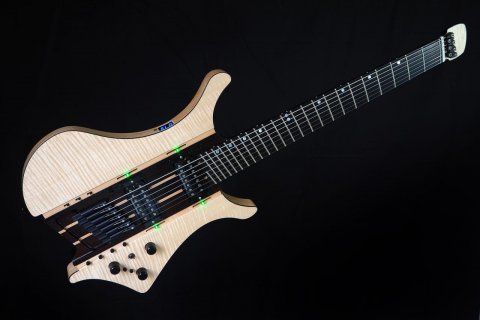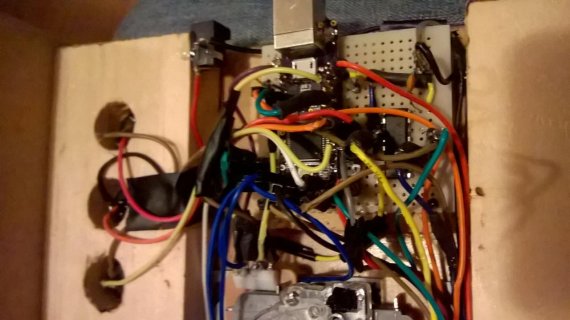snapperjonno
Member
I have spent a long time building a MIDI controller that is built into my electric guitar to control digital effects on iOS and PC/Mac. I have used a MidiCPU made by Highly Liquid (www.midicpu.com) as the 'brain' which works almost as well as I had hoped. I *think* that the MidiCPU is reaching the end of it production and is currently sold out, so I'm looking to find another processor to replace it with that will offer more potential for development and has a more secure future, and the Teensy seems the obvious choice.
Being a total noob to anything Arduino, can anyone please advise if I will be able to achieve what I need with the Teensy? It is important that the dimensions of all circuitry are a small as possible. With the MidiCPU I made a custom PCB shield to mount it on to make all the connections with Harwin M20 connectors on the wires plugging into to male headers on the shield, which was great and I envisage doing the same thing again with the new processor. It also carried all the resistors for the various LEDs.
Here's a list of everything I need to connect:
4x 10k slide potentiometers, to output MIDI CC messages
4x LEDs which are integrated into the slide pots
1x latching slide switch, to turn the pot LEDs on or off
1x rotary encoder - to increment and decrement a register, used to send a Program Change MIDI message to change presets
1x momentary switch, to actually send the Program Change message once selected with the encoder
1x 3-digit 7 segment LED display, to display chosen preset number selected with the encoder (1-128) - this uses up 11 pins on the MidiCPU
1x latching slide switch, to change the display to show(0-127) instead of (1-128) if required
1x momentary switch, to send a global refresh MIDI message
4x momentary switches, used like 'stomp' pedals to turn effects on and off - the sketch needs to make these work as latching
1x LED indicating processor activity (this isn't absolutely necessary)
1x MIDI out jack
1x 9V battery to power the device, I assume I'd need a regulator..?
1x latching slide switch, to turn the device on and off
I would also LOVE to build in Bluetooth wireless MIDI. I currently use a Quicco Sound Mi.1 (quicco.co.jp) plugged into the MID output, but I REALLY want to get the same connectivity built in...
So will all this be possible with the Teensy, and how which pins would I need to connect everything up to? In particular are there enough pins available..? How do I connect the 7 segment display using fewer connections but without increasing the footprint... how does the encoder connect?
And where could I get help with programming it? I have no experience with Arduino code and don't know where to start... I learnt the MidiCPU code so have some understand that may be relevant, but any help or suggestions would be very gratefully received.
Thanks!
Being a total noob to anything Arduino, can anyone please advise if I will be able to achieve what I need with the Teensy? It is important that the dimensions of all circuitry are a small as possible. With the MidiCPU I made a custom PCB shield to mount it on to make all the connections with Harwin M20 connectors on the wires plugging into to male headers on the shield, which was great and I envisage doing the same thing again with the new processor. It also carried all the resistors for the various LEDs.
Here's a list of everything I need to connect:
4x 10k slide potentiometers, to output MIDI CC messages
4x LEDs which are integrated into the slide pots
1x latching slide switch, to turn the pot LEDs on or off
1x rotary encoder - to increment and decrement a register, used to send a Program Change MIDI message to change presets
1x momentary switch, to actually send the Program Change message once selected with the encoder
1x 3-digit 7 segment LED display, to display chosen preset number selected with the encoder (1-128) - this uses up 11 pins on the MidiCPU
1x latching slide switch, to change the display to show(0-127) instead of (1-128) if required
1x momentary switch, to send a global refresh MIDI message
4x momentary switches, used like 'stomp' pedals to turn effects on and off - the sketch needs to make these work as latching
1x LED indicating processor activity (this isn't absolutely necessary)
1x MIDI out jack
1x 9V battery to power the device, I assume I'd need a regulator..?
1x latching slide switch, to turn the device on and off
I would also LOVE to build in Bluetooth wireless MIDI. I currently use a Quicco Sound Mi.1 (quicco.co.jp) plugged into the MID output, but I REALLY want to get the same connectivity built in...
So will all this be possible with the Teensy, and how which pins would I need to connect everything up to? In particular are there enough pins available..? How do I connect the 7 segment display using fewer connections but without increasing the footprint... how does the encoder connect?
And where could I get help with programming it? I have no experience with Arduino code and don't know where to start... I learnt the MidiCPU code so have some understand that may be relevant, but any help or suggestions would be very gratefully received.
Thanks!



